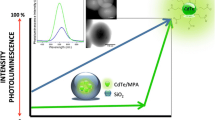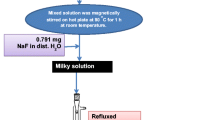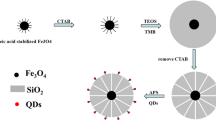Abstract
We report a new and convenient strategy for incorporating fluorescent semiconductor nanocrystals into silica hosts for the synthesis of multifunctional nanostructures. Mesoscale porosity was first created in conventional Stöber silica spheres by chemical etching under the protection of polymeric ligands. Uniform and highly luminescent CdSe nanocrystals were then directly grown in the porous silica network by reacting the silica spheres in a growth solution at high temperature. The confinement of silica network led to slower nanocrystal growth and subsequently smaller CdSe dots with blue shifted fluorescence compared with those without confinement. The loading number of CdSe nanocrystals can be easily tuned by changing the degree of porosity of the silica. The advantages of this strategy include simplicity as no special surface treatment processes are needed, general applicability to silica hosts of various shapes and sizes, high flexibility in tuning the dimensions of both the active nanocrystals and host particles, and ample opportunities for incorporating multiple functionalities. With the demonstration of a porous Fe3O4@SiO2/CdSe composite structure with combined magnetic and optical properties, we believe this strategy may provide a platform for the fabrication of a large variety of multifunctional composite nanostructures.
中文摘要
本文报道了一种新颖且便捷的将荧光半导体纳米晶包覆到二氧化硅球中进而制备多功能纳米结构的方法. 从溶胶凝胶法合成二氧化硅微球开始, 在聚合物配体保护下进行化学刻蚀从而获得介孔级孔道, 然后将带有孔道的二氧化硅微球投入到制备CdSe量子点的高温反应体系中, 就可以直接在二氧化硅微球的孔道中生长尺寸均匀且具有高荧光产率的CdSe纳米晶. 研究发现二氧化硅微球中的孔道对于CdSe量子点的生长有一定的抑制作用, 因此与自由生长的量子点比较其荧光光谱会发生蓝移, 二氧化硅微球中负载CdSe量子点的数量可以通过选择不同刻蚀程度的二氧化硅微球来实现. 这种纳米结构优点在于: 不需要特殊的表面处理工艺, 对于不同形貌及尺寸的二氧化硅微球具有普适性, 对于纳米晶与主体材料的尺寸调控具有较高的灵活性, 并且可以同时包裹其他功能材料, 比如将磁性纳米粒子引入到该体系, 合成了兼具磁学与光学性能的Fe3O4@SiO2/CdSe复合纳米结构材料. 该方法为制备多功能复合纳米结构材料提供了一个平台.
Similar content being viewed by others
References
Murray CB, Norris DJ, Bawendi MG. Synthesis and characterization of nearly monodisperse CdE (E = sulfur, selenium, tellurium) semiconductor nanocrystallites. J Am Chem Soc, 1993, 115: 8706–8715
Han M, Gao X, Su J, Nie S. Quantum-dot-tagged microbeads for multiplexed optical coding of biomolecules. Nat Biotechnol, 2001, 19: 631–635
Alivisatos AP. Semiconductor clusters, nanocrystals, and quantum dots. Science, 1996, 271: 933–937
Bruchez M, Moronne M, Gin P, Weiss S, Alivisatos AP. Semiconductor nanocrystals as fluorescent biological labels. Science, 1998, 281: 2013–2016
Murray CB, Kagan CR, Bawendi MG. Synthesis and characterization of monodispersenanocrystals and close-packed nanocrystalassemblies. Ann Rev Mater Sci, 2000, 30: 545–610
Chan WCW, Nie SM. Formation of high-quality CdTe, CdSe, and CdS nanocrystals using CdO as precursor. Science, 1998, 281: 2016–2018
Mattoussi H, Mauro JM, Goldman ER, et al. Self-assembly of CdSe- ZnS quantum dot bioconjugates using an engineered recombinant protein. J Am Chem Soc, 2000, 122: 12142–12150
Selvan ST, Patra PK, Ang CY, Ying JY. Synthesis of silica-coated semiconductor and magnetic quantum dots and their use in the imaging of live cells. Angew Chem Int Ed, 2007, 46: 2448–2452
Selvan ST, Tan TT, Ying JY. Robust, non-cytotoxic, silica-coated CdSe quantum dots with efficient photoluminescence. Adv Mater, 2005, 17: 1620–1625
Nann T, Mulvaney P. Single quantum dots in spherical silica particles. Angew Chem Int Ed, 2004, 43: 5393–5396
Gao XH, Nie SM. Quantum dot-encoded mesoporous beads with high brightness and uniformity: rapid readout using flow cytometry. Anal Chem, 2004, 76: 2406–2410
Song T, Zhang Q, Lu C, et al. Structural design and preparation of high-performance QD-encoded polymer beads for suspension arrays. J Mater Chem, 2011, 21: 2169–2177
Vaidya V, Couzis A, Maldarelli C. Reduction in aggregation and energy transfer of quantum dots incorporated in polystyrene beads by kinetic entrapment due to cross-linking during polymerization. Langmuir, 2015, 31: 3167–3179
Corato RD, Bigall NC, Ragusa A, et al. Multifunctional nanobeads based on quantum dots and magnetic nanoparticles: synthesis and cancer cell targeting and sorting. ACS Nano, 2011, 5: 1109–1121
Yang SJ, Nam S, Kim T, et al. Preparation and exceptional lithium anodic performance of porous carbon-coated ZnO quantum dots derived from a metal–organic framework. J Am Chem Soc, 2013, 135: 7394–7397
Liu H, Wu D, Liu Y, et al. Application of an optosensing chip based on molecularly imprinted polymer coated quantum dots for the highly selective and sensitive determination of sesamol in sesame oils. J Agric Food Chem, 2015, 63: 2545–2549
Chen PJ, Hu SH, Hung WH, Chen SY, Liu DM. Geometrical confinement of quantum dots in porous nanobeads with ultraefficient fluorescence for cell-specific targeting and bioimaging. J Mater Chem, 2012, 22: 9568–9575
Bao B, Li F, Li H, et al. pH-responsive dual fluorescent core–shell microspheres fabricated via a one-step emulsion polymerization. J Mater Chem C, 2013, 1: 3802–3807
Gao X, Nie S. Doping mesoporous materials with multicolor quantum dots. J Phys Chem B, 2003, 107: 11575–11578
Sathe TR, Agrawal A, Nie SM. Mesoporous silica beads embedded with semiconductor quantum dots and iron oxide nanocrystals: dual-function microcarriers for optical encoding and magnetic separation. Anal Chem, 2006, 78: 5627–5632
Gomez DE, Pastoriza-Santos I, Mulvaney P. Tunable whispering gallery mode emission from quantum-dot-doped microspheres. Small, 2005, 1: 238–241
Insin N, Tracy JB, Lee H, et al. Incorporation of iron oxide nanoparticles and quantum dots into silica microspheres. ACS Nano, 2008, 2: 197–202
Ki CD, Emrick T, Chang JY. Preparation of functional nanoporous silica for encapsulation of CdSe nanoparticles. Adv Mater, 2005, 17: 230–233
Mokari T, Sertchook H, Aharoni A, et al. Nano@micro: general method for entrapment of nanocrystals in sol-gel-derived composite hydrophobic silica spheres. Chem Mater, 2005, 17: 258–263
Zhelev Z, Ohba H, Bakalova R. Single quantum dot-micelles coated with silica shell as potentially non-cytotoxic fluorescent cell tracers. J Am Chem Soc, 2006, 128: 6324–6325
Ma Y, Li Y, Ma S, Bohn E. Highly bright water-soluble silica coated quantum dots with excellent stability. J Mater Chem B, 2014, 2: 5043–5051
Stober W, Fink A, Bohn E. Controlled growth of monodisperse silica spheres in the micron size range. J Colloid Interface Sci, 1968, 26: 62–69
Zhang Q, Zhang T, Ge J, Yin Y. Permeable silica shell through surface- protected etching. Nano Lett, 2008, 8: 2867–2871
Zhang Q, Ge J, Goebl J, et al. Rattle-type silica colloidal particles prepared by a surface-protected etching process. Nano Res, 2009, 2: 583–591
Ge J, Hu Y, Biasini M, Beyermann WP, Yin Y. Superparamagnetic magnetite colloidal nanocrystal clusters. Angew Chem Int Ed, 2007, 46: 4342–4345
Ge J, Yin Y. Magnetically tunable colloidal photonic structures in alkanol solutions. Adv Mater, 2008, 20: 3485–3491
Peng ZA, Peng X. Nearly monodisperse and shape-controlled CdSe nanocrystals via alternative routes: nucleation and growth. J Am Chem Soc, 2002, 124: 3343–3353
Grabolle M, Spieles M, Lesnyak V, et al. Determination of the fluorescence quantum yield of quantum dots: suitable procedures and achievable uncertainties. Anal Chem, 2009, 81: 6285–6294
Yu W, Qu L, Guo W, Peng X. Experimental determination of the extinction coefficient of CdTe, CdSe, and CdS nanocrystals. Chem Mater, 2003, 15: 2854–2860
Sommer J, Yang Y, Rambow D, Blumel J. Immobilization of phosphines on silica: identification of byproducts via 31P CP/MAS studies of model alkyl-, aryl-, and ethoxyphosphonium salts. Inorg Chem, 2004, 43: 7561–7563
Blumel J. Reactions of phosphines with silicas: a solid-state NMR study. Inorg Chem, 1994, 33: 5050–5056
Max TO. High-angle annular dark-field imaging on a TEM/STEM system. J Electron Microsc Tech, 1991, 17: 221–230
Author information
Authors and Affiliations
Corresponding author
Additional information
Chunguang Li received her PhD degree from the Department of Chemistry, Jilin University, Changchun, in 2010. Currently, she is an engineer at the State Key Laboratory of Inorganic Synthesis & Preparative Chemistry, Jilin University. Her research interests focuses on fabrication of colloidal inorganic nanostructures and their applications in biochemistry and photoelectronic fields.
Yadong Yin received his PhD degree in materials science and engineering from the University of Washington in 2002, then worked as a postdoctoral fellow at the University of California, Berkeley and the Lawrence Berkeley National Laboratory (LBNL), and became a staff scientist at LBNL in 2005. In 2006 he joined the faculty at the Department of Chemistry at the University of California, Riverside. His research interests include the synthesis and application of nanostructured materials, self-assembly processes, and colloidal and interface chemistry.
Electronic supplementary material
Rights and permissions
About this article
Cite this article
Li, C., Lu, Z., Zhang, Q. et al. Confined growth of CdSe quantum dots in colloidal mesoporous silica for multifunctional nanostructures. Sci. China Mater. 58, 481–489 (2015). https://doi.org/10.1007/s40843-015-0056-z
Received:
Accepted:
Published:
Issue Date:
DOI: https://doi.org/10.1007/s40843-015-0056-z




